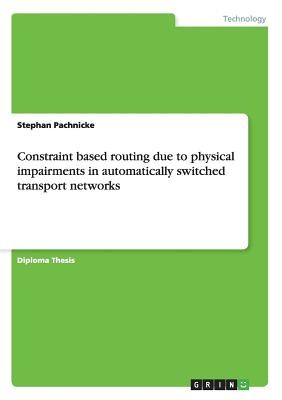
- We will send in 10–14 business days.
- Author: Stephan Pachnicke
- Publisher: GRIN Verlag
- Year: 2008
- Pages: 100
- ISBN-10: 3638934330
- ISBN-13: 9783638934336
- Format: 14.8 x 21 x 0.6 cm, softcover
- Language: English
- SAVE -10% with code: EXTRA
Constraint based routing due to physical impairments in automatically switched transport networks (e-book) (used book) | bookbook.eu
Reviews
Description
Diploma Thesis from the year 2002 in the subject Electrotechnology, grade: 1,0, University of Dortmund (Lehrstuhl für Hochfrequenztechnik), language: English, abstract: Next generation optical communication systems will be characterized by increasing data rates, high signal powers and dense wavelength division multiplexing (DWDM). In future-optical networks channels will be routed through complex, meshed networks (ASTN, Automatically Switched Transport Networks, ITU-T Recommendation G.808 0/Y.1304). These networks will be able to setup transparent optical paths without converting the optical signals to electrical signals. In all-optical networks the physical impairments and degradation effects play an important role. There is a multitude of degradation effects like dispersion, noise, crosstalk, fiber nonlinearities, polarization dependent loss, etc. To enable a fast setup and the best choice of one of the available paths, the signal quality along the whole transmission distance has to be evaluated very fast. Ideally, only a single figure of merit (FOM), e.g. the bit error rate (BER), will be computed, which incorporates all degradation effects. Therefore it is important to characterize the different physical impairments analytically. Signal distortions can be measured by an eye opening penalty (EOP) and degradation effects due to noise by the optical signal-to-noise ratio (OSNR). The goal is to find and calculate these impairments from the signal parameters (modulation format, data rate, duty cycle, channel spacing, etc.) as well as the route parameters (fiber lengths and parameters, EDFA powers, etc.). Due to the need of fast routing algorithms, time-consuming numerical methods or a complete system simulation are not practical. In addition, it is not possible to linearly accumulate the different degradation effects. The focus of this work is to find analytical or heuristic formulas for each degradation effect. These approximation formulas are compared to the resu
EXTRA 10 % discount with code: EXTRA
The promotion ends in 17d.01:09:48
The discount code is valid when purchasing from 10 €. Discounts do not stack.
- Author: Stephan Pachnicke
- Publisher: GRIN Verlag
- Year: 2008
- Pages: 100
- ISBN-10: 3638934330
- ISBN-13: 9783638934336
- Format: 14.8 x 21 x 0.6 cm, softcover
- Language: English English
Diploma Thesis from the year 2002 in the subject Electrotechnology, grade: 1,0, University of Dortmund (Lehrstuhl für Hochfrequenztechnik), language: English, abstract: Next generation optical communication systems will be characterized by increasing data rates, high signal powers and dense wavelength division multiplexing (DWDM). In future-optical networks channels will be routed through complex, meshed networks (ASTN, Automatically Switched Transport Networks, ITU-T Recommendation G.808 0/Y.1304). These networks will be able to setup transparent optical paths without converting the optical signals to electrical signals. In all-optical networks the physical impairments and degradation effects play an important role. There is a multitude of degradation effects like dispersion, noise, crosstalk, fiber nonlinearities, polarization dependent loss, etc. To enable a fast setup and the best choice of one of the available paths, the signal quality along the whole transmission distance has to be evaluated very fast. Ideally, only a single figure of merit (FOM), e.g. the bit error rate (BER), will be computed, which incorporates all degradation effects. Therefore it is important to characterize the different physical impairments analytically. Signal distortions can be measured by an eye opening penalty (EOP) and degradation effects due to noise by the optical signal-to-noise ratio (OSNR). The goal is to find and calculate these impairments from the signal parameters (modulation format, data rate, duty cycle, channel spacing, etc.) as well as the route parameters (fiber lengths and parameters, EDFA powers, etc.). Due to the need of fast routing algorithms, time-consuming numerical methods or a complete system simulation are not practical. In addition, it is not possible to linearly accumulate the different degradation effects. The focus of this work is to find analytical or heuristic formulas for each degradation effect. These approximation formulas are compared to the resu


Reviews